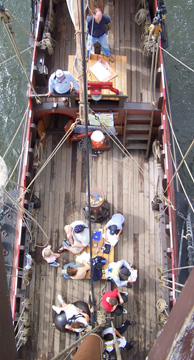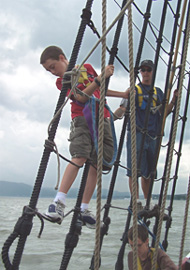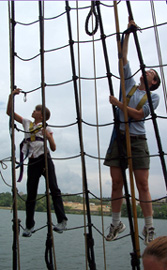 |
|
|
|
|
During our Voyages of Discovery, we maintain and operate the Half Moon much like Captain Hudson and his crew would have during their venture to the New World in 1609. Our student crew members spend a week fully immersed in 17th century ship life. Handling any given aspect of the Half Moon can require -- and teach -- a range of different skills. First Leg Shipcraft | |
Quicklinks Line Handling
|
The first thing any new crew member needs to do upon boarding a sailing ship is to literally "learn the ropes." However, handling a ship like the Half Moon can seem like quite a challenge. After all, this ship utilizes miles of rope (or "lines"), and each line serves a specific purpose. Handling a single sail may mean mastering a dozen separate lines. That said, these seemingly intimidating feats actually boil down to a series of very simple tasks. Thus, mastering the Half Moon begins with just a few basic skills: coiling a rope and tying a knot. When our students first come on board, we teach them how to properly belay and coil a line. To belay a line is to securely lash it to a belaying pin on the pin rail, so that it will not slip loose on its own, but can be quickly removed if need be. Properly coiling ropes reduces wear on the lines and keeps the deck tidy, which keeps the lines from snagging on each other or tripping the crew. Above, you can see our students practicing these skills. A good sailor should also know his or her knots. A line can be tied into dozens of different types of knots, and like the lines themselves, each type of knot is best when put to specific uses. However, your average crew member can go a long way just mastering three basic knots: the square knot (not a granny!), the half-hitch, and the bowline. To the right, Mrs. Colley helps Kyle figure out a tricky knot. |
|
Sail HandlingNow that our new crew is familiar with the running rigging, they can put their skills to use. In a sense, operating a sailing ship like the Half Moon is like manipulating a giant marionette, with each line moving a specific yardarm or sail in a specific way. Handling the sails requires a lot of hands, and thus a lot of cooperation. We were impressed by how quickly our students came together in their mast teams and grasped the basics of sail handling. Because of this, we were able to sail off the dock when we left King Marine. This is no simple task! Above, you can see our students dividing into their mast teams (one team works the fore mast, while the other works the main mast). The mast teams must coordinate their efforts to effectively steer and propel the ship when under sail. |
|
Working in the RigClimbing the standing rigging (the black, ladder-like seen in these photos) is one of the most exciting challenges awaiting the crew of the Half Moon. Our crew member "go aloft" to furl and unfurl the sails and to work the top sails. In some cases, our student crew members may also climb the rig as part of their scientific experiments, such as Ericka and Madena comparing wind speeds on deck and in the tops. As one might well expect, however, climbing the rigging bears a inherent risk that simply cannot be ignored. In fact, some of our crew, both adults and students, choose not to climb for various reasons. We should stress that it is perfectly possible to be a productive and valued member of our crew without ever having your feet leave the deck. However, most of our crew do choose to climb. Some crew members who are initially wary of the ship's heights consider the rigging a personal challenge to overcome. To prevent accidents, even our most eager climbers must master our ship's safety protocols before they are allowed to climb. First, new crew members must learn how to correctly fasten and use a safety harness. To the above left, you can see Mr. Dawson, Mr. Colley, and Mr. Morel helping some of our students test each other for a snug fit. |
|
Once our crew members have learned the ins and outs of their safety harnesses, they can climb into the rig (with adult supervision). Before they can truly go aloft, however, they have a few more challenges. First, they must always adhere to the principle of "three-point contact." Of the four limbs climbers use to steady themselves -- two hands and two feet -- three must have a firm grip at all times. This way, in the event that a hand or foot does slip, they still have two points of contact supporting them. New climbers must also perform a hang test, in which they hang just by their hands from the shrouds for about ten seconds. This shows us that the crew member can support his or her weight, and it teaches the climber just how tight a grip he or she really needs to keep herself secure in case of a slip. Above, you can see Madena, Kyle, and Riki in various stages of their hang tests. Everyone passed with flying colors are were soon on their way aloft to work the sails and perform experiments. |
|
MarlinspikeIn the 17th century, sailors spent much of their free time crafting and repairing gear for the ship. Every element of a sailing ship required constant maintenance -- which is still true today. Little on a ship wore out more quickly than its rope; our word "junk" was originally a nautical term for rope that was too worn to be usable. Sailors thus had ample opportunity to practice their craftwork and plenty of scrap rope to work with. The art of rope use, or marlinspike, grew out of this utilitarian reality. Here on the replica ship Half Moon, we continue this fine tradition today. Our crew members, both students and adults, have hand-crafted many of the tools we use on board. On this voyage, Mr. Morel put his own marlinspike skills to work when we needed to replenish our water supply. Grabbing a bit of spare rope, Mr. Morel created the cargo netting above, just the right size to hoist water jugs up onto the ship. |
|
Our students also learn how to determine their position on a map. Using a hand-bearing compass, such as the one Mr. Colley is using to the right and Ciara and Shannon are examining below, the crew sights three known landmarks. By plotting the compass direction of each landmark, the crew member can triangulate his or her own location with a reasonable degree of accuracy.
|
|
|
|
|
As anyone who's ever served onboard a ship can tell you, the ship's cook may not be the most glamorous job, but it's undoubtedly one of the most vital. Our cook toils endlessly to prepare three healthy meals a day for two dozen hungry crew members. Traditionally, our cook also acts as a confidante to the crew (not to mention cooking the occasional surprise birthday cake). Fortunately, our cook does have some help. The student crew took turns serving as Mrs. Lawler's assistant as part of their regular crew roster, giving them an rapid introduction to the logistical challenges of keeping an entire ship's crew fed on time. As you can see above, our students helped Mrs. Lawler in whatever ways were needed -- be it cleaning dishes, preparing meals, or making desserts. (So, parents, if your children return from the Half Moon claiming that they don't know how to clean up a kitchen -- don't believe it.) |
|


